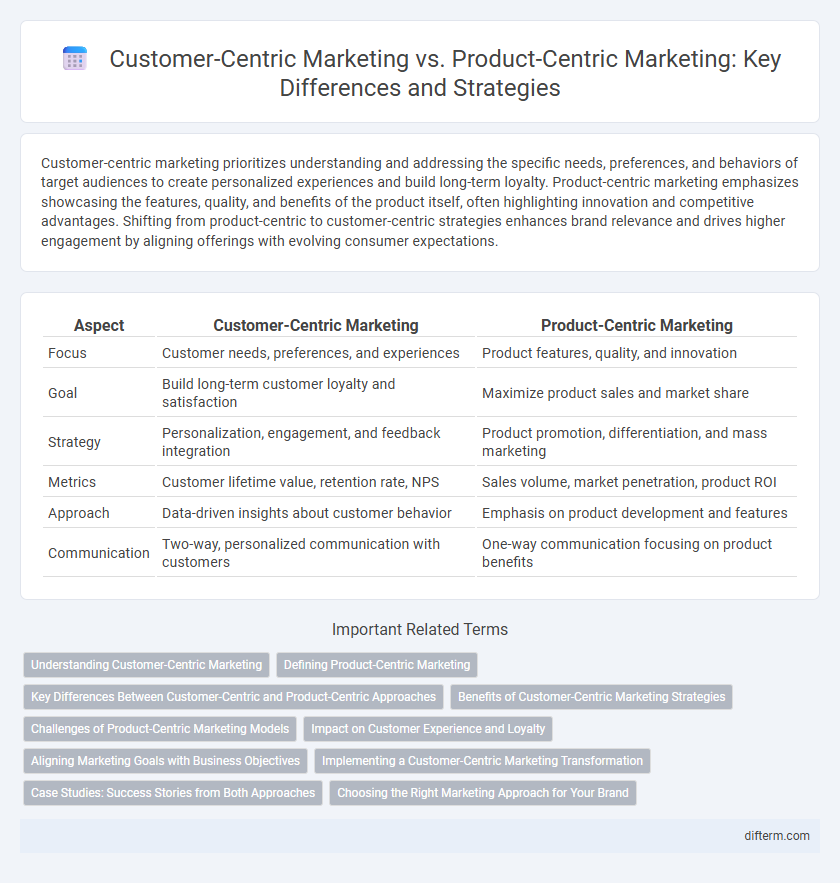Customer-centric marketing prioritizes understanding and addressing the specific needs, preferences, and behaviors of target audiences to create personalized experiences and build long-term loyalty. Product-centric marketing emphasizes showcasing the features, quality, and benefits of the product itself, often highlighting innovation and competitive advantages. Shifting from product-centric to customer-centric strategies enhances brand relevance and drives higher engagement by aligning offerings with evolving consumer expectations.
Table of Comparison
| Aspect | Customer-Centric Marketing | Product-Centric Marketing |
|---|---|---|
| Focus | Customer needs, preferences, and experiences | Product features, quality, and innovation |
| Goal | Build long-term customer loyalty and satisfaction | Maximize product sales and market share |
| Strategy | Personalization, engagement, and feedback integration | Product promotion, differentiation, and mass marketing |
| Metrics | Customer lifetime value, retention rate, NPS | Sales volume, market penetration, product ROI |
| Approach | Data-driven insights about customer behavior | Emphasis on product development and features |
| Communication | Two-way, personalized communication with customers | One-way communication focusing on product benefits |
Understanding Customer-Centric Marketing
Customer-centric marketing prioritizes understanding customer needs, preferences, and behaviors to tailor personalized experiences that drive loyalty and satisfaction. This approach leverages data analytics and customer feedback to create value, strengthen relationships, and enhance long-term profitability. Brands embracing customer-centric strategies outperform product-centric models by aligning marketing efforts with evolving consumer demands and delivering relevant solutions.
Defining Product-Centric Marketing
Product-centric marketing prioritizes the features, quality, and innovation of the product itself, aiming to highlight its unique selling points to attract consumers. This approach often emphasizes product development, enhancements, and technical specifications as key drivers of marketing strategies. Companies using product-centric marketing focus on creating superior products, assuming that customer demand naturally follows product excellence.
Key Differences Between Customer-Centric and Product-Centric Approaches
Customer-centric marketing prioritizes understanding and meeting customer needs, leveraging data-driven insights to personalize experiences and build long-term loyalty, whereas product-centric marketing emphasizes product features, innovation, and improvements with the goal of driving sales. Key differences include the orientation of strategies: customer-centric approaches align messaging and development around customer behaviors and preferences, while product-centric models focus on product development cycles and competitive differentiation. Metrics also diverge, as customer-centric marketing tracks customer satisfaction, retention, and lifetime value, contrasting with product-centric emphasis on sales volume and market share.
Benefits of Customer-Centric Marketing Strategies
Customer-centric marketing strategies enhance customer loyalty by prioritizing personalized experiences and addressing specific needs, leading to increased customer retention and higher lifetime value. This approach harnesses data analytics to tailor communications and products, improving overall customer satisfaction and driving word-of-mouth referrals. By focusing on customer insights, businesses can adapt quickly to market changes and build stronger, long-term relationships that boost revenue growth.
Challenges of Product-Centric Marketing Models
Product-centric marketing models often struggle with limited customer insights, resulting in products that may not fully address market needs or evolving consumer preferences. This approach can lead to reduced customer engagement and loyalty due to its emphasis on product features rather than personalized experiences. Companies may also face challenges in adapting to market shifts quickly, as product-focused strategies typically prioritize internal capabilities over external customer feedback.
Impact on Customer Experience and Loyalty
Customer-centric marketing enhances customer experience by tailoring messages and products to individual needs, fostering deeper emotional connections and higher satisfaction levels. Product-centric marketing prioritizes product features and benefits, which can overlook customer preferences, potentially reducing engagement and loyalty over time. Emphasizing customer-centric strategies drives repeat purchases and brand advocacy, significantly boosting long-term loyalty metrics.
Aligning Marketing Goals with Business Objectives
Customer-centric marketing prioritizes understanding and addressing customer needs to drive loyalty and revenue growth, directly aligning marketing goals with overall business objectives by fostering long-term relationships and personalized experiences. Product-centric marketing focuses on promoting product features and innovations, aiming to enhance market share but often risks misalignment with evolving customer demands. Aligning marketing goals with business objectives requires integrating customer insights and market trends to ensure strategies support both customer satisfaction and sustainable business growth.
Implementing a Customer-Centric Marketing Transformation
Implementing a customer-centric marketing transformation requires shifting focus from product features to understanding and addressing customer needs, behaviors, and preferences through data-driven insights. This approach enhances customer engagement and loyalty by delivering personalized experiences and value at every touchpoint. Marketing strategies must leverage CRM systems, customer journey mapping, and predictive analytics to align messaging and offerings with evolving customer expectations.
Case Studies: Success Stories from Both Approaches
Case studies reveal that customer-centric marketing drives higher engagement by tailoring campaigns to individual preferences, as exemplified by Amazon's personalized recommendations boosting sales by 29%. Product-centric marketing, demonstrated by Apple's consistent brand messaging around innovation, achieves strong market positioning and loyal customer bases. Both approaches prove effective when aligned with clear business goals and data-driven strategies.
Choosing the Right Marketing Approach for Your Brand
Choosing the right marketing approach hinges on aligning strategies with your brand's core values and target audience needs. Customer-centric marketing emphasizes personalized experiences and engagement, driving loyalty through deep understanding of consumer behavior and preferences. Product-centric marketing focuses on highlighting features and innovations, appealing to market demand by showcasing the unique qualities and benefits of the product itself.
Customer-centric marketing vs product-centric marketing Infographic

 difterm.com
difterm.com